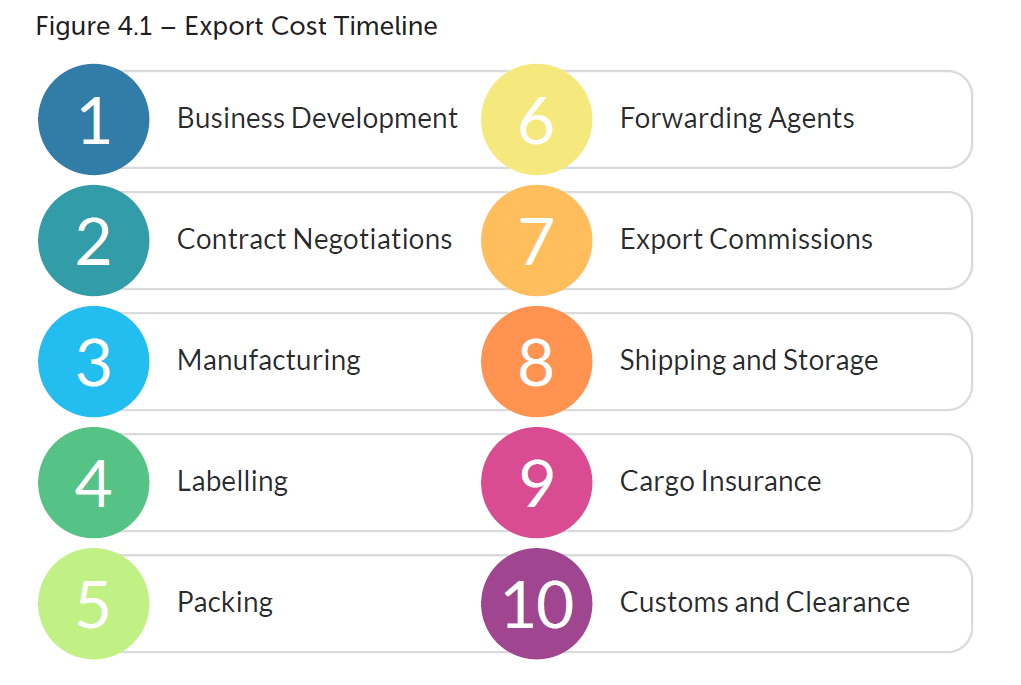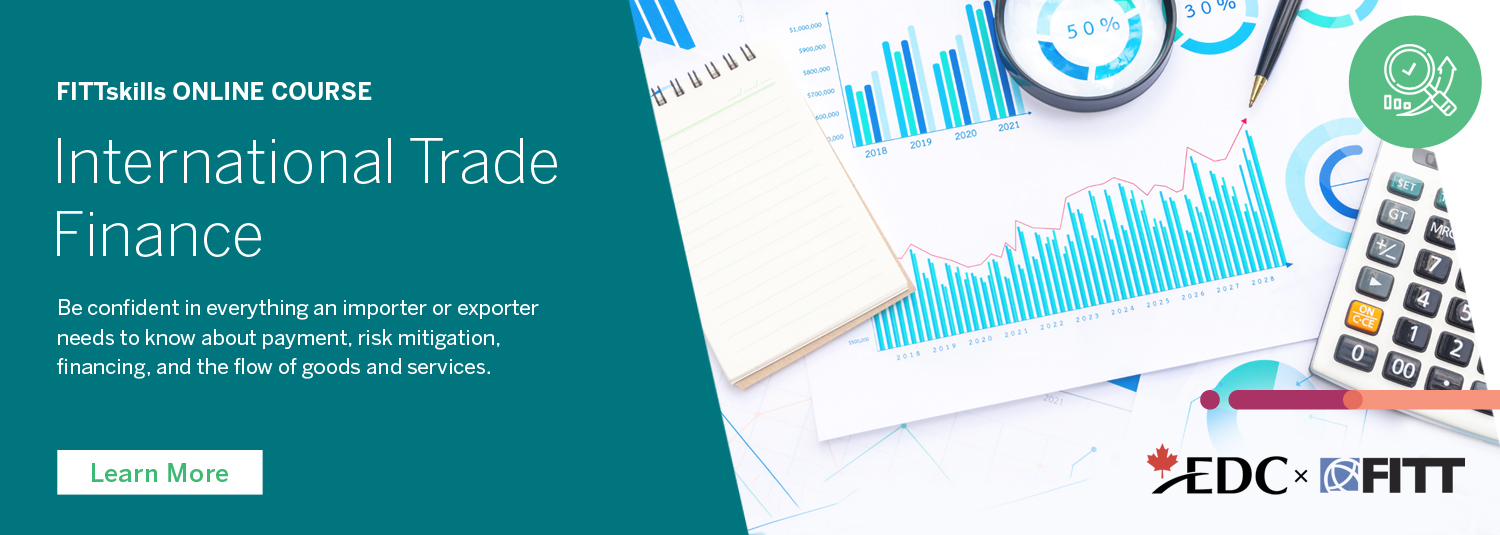
Businesses that operate internationally need to treat their cash flow planning differently than those that operate domestically. There are many additional details to consider for international transactions, including export costs which, ideally, should be determined alongside a timeline that tracks where and when these costs are incurred and when they are due for payment. These costs can be added to the company’s domestic costing worksheet to help the exporter fully understand the cash flow implications of trading internationally.
To help you understand more about some of these common costs in international business, we’ve compiled a list of 10 export costs you need to consider when projecting cash outflows along with an export cost timeline.
Figure 4.1 arranges typical export costs in the order in which they occur as a first step to projecting cash outflows.

For businesses that deal with importing and exporting in their operations, it is important to know which of these costs are the responsibility of the exporter and which ones are the responsibility of the importer. This can be easily determined by looking at the Incoterms® rules negotiated between the two parties during contract negotiations.
Want to learn more about Incoterms® rules? Take the Incoterms® 2020 online course, presented by FITT and the Canadian Chamber of Commerce (CCC).
The chosen Incoterms® rule determines the importer’s obligations and the exporter’s obligations, such as who pays the cost of transport, delivery and insurance. Learn more about these export costs below:
1. Business Development Costs
Even before the signing of a deal, there are various business development costs associated with making the sale. These may include travel, telephone and fax, promotional and marketing costs, legal fees, and possibly foreign agent’s fees. Most of these costs must be paid up front, regardless of when/if a deal generates revenues. These initial costs can impose a significant burden on the cash flow, which may make the need for financing even more urgent.
2. Contract Negotiations
Once the importer shows interest in dealing with the exporter, both parties begin negotiating a firm contract. Depending on the complexity of the product, contract negotiations require input from many professionals. A lawyer may be required to help negotiate terms and conditions that secure each party in the event of contract cancellation, non-performance and non-payment, among many other possible scenarios. At times, contract negotiations can take many months, if not years, to conclude. The time invested during this time is at the cost of each company with no compensation other than the hope that the contract with bring fruitful benefits to each company.
3. Manufacturing Cost Per Unit
In most cases, these costs are the same as those for domestic transactions, except where production is modified to meet specific foreign requirements. Coverage of these costs may fall under the company’s existing credit arrangements, unless the export effort is significantly large in comparison with the company’s current capacities. Some differences can occur with product cost per unit if the order is large enough, and special costs will therefore have to be borne. New employees, added export administration, extra factory space, and more expensive materials may be necessary. In that case, a new cash flow worksheet must be completed to factor in the additional costs relative to expected revenues.
Did you know that you can preview FITTskills courses for FREE? This topic is covered in the FITTskills Lite Unit on Cash Flow Management. Get the download below: ⬇️
4. Labelling
This is one of the up-front costs incurred in exporting. If it’s done in-house, there will need to be special print runs and adjustments made to machinery, although the out-of-pocket costs may be minimal. For many overseas markets, they may need label information translated. If contracting out both translation and printing, the exporter can expect that payment for these services will be due within 30 to 60 days after the order is complete.
5. Packing
Shipments must be ready for international transportation. Many countries have strict regulations. Even if the packings done in-house, the exporting firm may have to purchase materials, such as crates, boards or Styrofoam. Payment for these materials will be within 30 to 60 days of delivery. If packings done by an external supplier, such as a freight forwarder, the costs will be even more significant. In some instances, it may be possible to secure extended payment terms from suppliers in recognition of the length of time that will pass before receivables are paid.
Want to learn more about methods of settlement in international trade and other risk mitigation options? Check out the FITTskills International Trade Finance online course.

6. Forwarding Agents Fees
The forwarding agent’s fees cover activities such as preparing documents, securing insurance and arranging for transportation. These fees are usually payable in 30 to 60 days after loading the shipment onto an international carrier. The timing of the costs may be negotiable, but the negotiation must finish before the transaction occurs.
7. Export Commissions
To earn an export commission the signing of an export transaction must occur, but payment terms may be negotiable. The exporting company should try to move the due date for payment of commissions either close to or past the date on which it expects to receive payment from the importer. If the company is factoring the transaction, however, it may be able to pay sooner without impairing cash flow.
8. Shipping and Storage Costs
The shipping process entails many costs, payable to a wide variety of service providers. Freight forwarders, domestic carriers, port authorities, and international carriers may all perform services requiring payment. As suppliers of shipping services are familiar with the realities of international trade, they may agree to payment terms that are common among domestic suppliers.
9. Cargo Insurance
This cost is payable within 30 to 60 days of shipment. Shippers may offer extended cargo insurance as part of their service and may thus accord extended payment terms for it. Otherwise, factor this cost into a transaction as being payable before receiving the full funds for deliverables. If packings done by an external supplier, such as a freight forwarder, the costs will be even more significant. It’s possible to secure extended payment terms from suppliers in recognition of time that will pass before paying for receivables.
10. Customs and Clearance Fees
Customs and clearance fees are due immediately on arrival of the shipment in the destination country. For customs brokers employed to clear the goods, those fees add to the other costs. If the contract specifies that the exporting firm is responsible for this part of the transaction, the firm will need cash on hand to cover these costs before the goods can be landed and delivered to their destination.
By keeping these costs in mind, an exporter will be able to work through the cash flow forecasts and ensure the cash inflows match the cash outflows as much as possible to minimize the company’s reliance on financing. This exercise can also help the company negotiate the milestone payments and ensure it follows the contract completion to minimize payment default in future.
Other Costs
The export costing calculation offers an indication of some of the other costs involved in a transaction. It also gives clues as to when they might affect the cash flow. For example, paid monthly for the duration of the transaction are insurance premiums. By contrast, you only feel the impact of discounting a receivable when the receivable sells. Among other costs to consider are receivables insurance, contract cancellation insurance and various financing charges. When using a line of credit these might be paid monthly or at the end as part of the collection and settlement process.






disqus comments